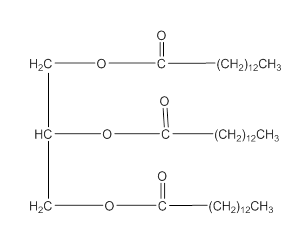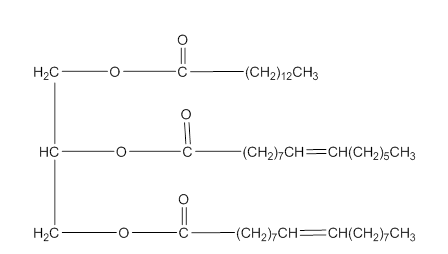
General, Organic, & Biological Chemistry
3rd Edition
ISBN: 9780073511245
Author: Janice Gorzynski Smith Dr.
Publisher: McGraw-Hill Education
expand_more
expand_more
format_list_bulleted
Concept explainers
Question
Chapter 19.5, Problem 19.15P
Interpretation Introduction
(a)
Interpretation:
Composition of the soap formed by basic hydrolysis of the following triacylglycerol should be determined:

Concept Introduction:
Soaps are made by combining the base and
Soaps are created by base hydrolyze of triacylglycerol. This process is known as saponification.
Interpretation Introduction
(b)
Interpretation:
Composition of the soap formed by basic hydrolysis of the following triacylglycerol should be determined:

Concept Introduction:
Soaps are made by combining base and carboxylic acids. Therefore, salts are metal salts of carboxylic acids.
Soaps are created by base hydrolyze of triacylglycerol. This process is known as saponification.
Expert Solution & Answer
Want to see the full answer?
Check out a sample textbook solution
Students have asked these similar questions
Extra for Experts: Your Future in Chemistry.
As you now know, there are countless jobs that involve chemistry!
Research a chemistry profession that interests you. In your answer, discuss which aspects of the job most appeal to you.
MISSED THIS? Read Section 19.9 (Pages 878-881); Watch IWE 19.10
Consider the following reaction:
CH3OH(g)
CO(g) + 2H2(g)
(Note that AG,CH3OH(g) = -162.3 kJ/mol and AG,co(g)=-137.2 kJ/mol.)
Part A
Calculate AG for this reaction at 25 °C under the following conditions:
PCH₂OH
Pco
PH2
0.815 atm
=
0.140 atm
0.170 atm
Express your answer in kilojoules to three significant figures.
Ο ΑΣΦ
AG = -150
Submit
Previous Answers Request Answer
□?
kJ
× Incorrect; Try Again; 2 attempts remaining
Calculate the free energy change under nonstandard conditions (AGrxn) by using the following relationship:
AGrxn = AGrxn + RTInQ,
AGxn+RTInQ,
where AGxn is the standard free energy change, R is the ideal gas constant, T is the temperature in kelvins, a
is the reaction quotient.
Provide Feedback
Next >
Identify and provide a brief explanation of Gas Chromatography (GC) within the context of chemical analysis of food. Incorporate the specific application name, provide a concise overview of sample preparation methods, outline instrumental parameters and conditions ultilized, and summarise the outcomes and findings achieved through this analytical approach.
Chapter 19 Solutions
General, Organic, & Biological Chemistry
Ch. 19.1 - Prob. 19.1PCh. 19.1 - Prob. 19.2PCh. 19.2 - Prob. 19.3PCh. 19.2 - Prob. 19.4PCh. 19.2 - Prob. 19.5PCh. 19.3 - Prob. 19.6PCh. 19.3 - Prob. 19.7PCh. 19.3 - Prob. 19.8PCh. 19.3 - Prob. 19.9PCh. 19.4 - Prob. 19.10P
Ch. 19.4 - Prob. 19.11PCh. 19.4 - Prob. 19.12PCh. 19.4 - Prob. 19.13PCh. 19.5 - Review Section 5.2 on balancing chemical...Ch. 19.5 - Prob. 19.15PCh. 19.6 - Prob. 19.16PCh. 19.6 - Prob. 19.17PCh. 19.7 - Prob. 19.18PCh. 19.7 - Prob. 19.19PCh. 19.7 - Prob. 19.20PCh. 19.8 - Prob. 19.21PCh. 19.8 - Prob. 19.22PCh. 19.8 - Identify the functional groups in (a)...Ch. 19.9 - Compare the structures of estrone and...Ch. 19.9 - Prob. 19.25PCh. 19.10 - Prob. 19.26PCh. 19.11 - Prob. 19.27PCh. 19.11 - Prob. 19.28PCh. 19 - Label each compound as a hydrolyzable or...Ch. 19 - Label each compound as a hydrolyzable or...Ch. 19 - Prob. 19.31PCh. 19 - In which solvents or solutions might a steroid be...Ch. 19 - Prob. 19.33PCh. 19 - Prob. 19.34PCh. 19 - Prob. 19.35PCh. 19 - Prob. 19.36PCh. 19 - Some fish oils contain triacylglycerols formed...Ch. 19 - Some marine plankton contain triacylglycerols...Ch. 19 - Prob. 19.39PCh. 19 - Prob. 19.40PCh. 19 - Prob. 19.41PCh. 19 - Prob. 19.42PCh. 19 - What hydrolysis products are formed when each wax...Ch. 19 - What hydrolysis products are formed when each wax...Ch. 19 - Prob. 19.45PCh. 19 - Prob. 19.46PCh. 19 - Prob. 19.47PCh. 19 - Prob. 19.48PCh. 19 - Prob. 19.49PCh. 19 - Prob. 19.50PCh. 19 - Consider the following four types of compounds:...Ch. 19 - Prob. 19.52PCh. 19 - Answer the following questions about the given...Ch. 19 - Prob. 19.54PCh. 19 - Prob. 19.55PCh. 19 - Prob. 19.56PCh. 19 - Prob. 19.57PCh. 19 - Prob. 19.58PCh. 19 - Prob. 19.59PCh. 19 - Prob. 19.60PCh. 19 - Draw a phospholipid that fits each description. a...Ch. 19 - Draw a phospholipid that fits each description. a...Ch. 19 - Prob. 19.63PCh. 19 - Prob. 19.64PCh. 19 - Prob. 19.65PCh. 19 - Prob. 19.66PCh. 19 - Why must cholesterol be transported through the...Ch. 19 - Prob. 19.68PCh. 19 - Describe the role of HDLs and LDLs in cholesterol...Ch. 19 - Prob. 19.70PCh. 19 - (a) Draw the structure of an estrogen and an...Ch. 19 - Prob. 19.72PCh. 19 - What are the similarities and differences between...Ch. 19 - Prob. 19.74PCh. 19 - Prob. 19.75PCh. 19 - List three biological functions of prostaglandins...Ch. 19 - Explain why aspirin and celecoxib differ in how...Ch. 19 - How does zileuton treat the cause of asthma, not...Ch. 19 - Answer each question with regards to vitamins A...Ch. 19 - Answer each question in Problem 19.79 for vitamins...Ch. 19 - Prob. 19.81PCh. 19 - Prob. 19.82PCh. 19 - Prob. 19.83PCh. 19 - Prob. 19.84PCh. 19 - Prob. 19.85PCh. 19 - Prob. 19.86PCh. 19 - Prob. 19.87PCh. 19 - Prob. 19.88PCh. 19 - The main fatty acid component of the...Ch. 19 - Prob. 19.90PCh. 19 - Prob. 19.91PCh. 19 - Prob. 19.92PCh. 19 - Can an individual survive on a completely fat-free...Ch. 19 - Prob. 19.94PCh. 19 - Prob. 19.95PCh. 19 - Prob. 19.96PCh. 19 - Prob. 19.97PCh. 19 - Prob. 19.98PCh. 19 - Prob. 19.99CPCh. 19 - Prob. 19.100CP
Knowledge Booster
Learn more about
Need a deep-dive on the concept behind this application? Look no further. Learn more about this topic, chemistry and related others by exploring similar questions and additional content below.Similar questions
- Identify and provide a concise explanation of the concept of signal-to-noise ratio (SNR) in the context of chemical analysis. Provide specific examples.arrow_forwardIdentify and provide a concise explanation of a specific analytical instrument capable of detecting and quantifying trace compounds in food samples. Emphasise the instrumental capabilities relevant to trace compound analysis in the nominated food. Include the specific application name (eg: identification and quantification of mercury in salmon), outline a brief description of sample preparation procedures, and provide a summary of the obtained results from the analytical process.arrow_forwardIdentify and provide an explanation of what 'Seperation Science' is. Also describe its importance with the respect to the chemical analysis of food. Provide specific examples.arrow_forward
- 5. Propose a Synthesis for the molecule below. You may use any starting materials containing 6 carbons or less (reagents that aren't incorporated into the final molecule such as PhзP do not count towards this total, and the starting material can have whatever non-carbon functional groups you want), and any of the reactions you have learned so far in organic chemistry I, II, and III. Your final answer should show each step separately, with intermediates and conditions clearly drawn. H3C CH3arrow_forwardState the name and condensed formula of isooxazole obtained by reacting acetylacetone and hydroxylamine.arrow_forwardState the name and condensed formula of the isothiazole obtained by reacting acetylacetone and thiosemicarbazide.arrow_forward
- Provide the semi-developed formula of isooxazole obtained by reacting acetylacetone and hydroxylamine.arrow_forwardGiven a 1,3-dicarbonyl compound (R1-CO-CH2-CO-R2), indicate the formula of the compound obtaineda) if I add hydroxylamine (NH2OH) to give an isooxazole.b) if I add thiosemicarbazide (NH2-CO-NH-NH2) to give an isothiazole.arrow_forwardAn orange laser has a wavelength of 610 nm. What is the energy of this light?arrow_forward
- The molar absorptivity of a protein in water at 280 nm can be estimated within ~5-10% from its content of the amino acids tyrosine and tryptophan and from the number of disulfide linkages (R-S-S-R) between cysteine residues: Ε280 nm (M-1 cm-1) ≈ 5500 nTrp + 1490 nTyr + 125 nS-S where nTrp is the number of tryptophans, nTyr is the number of tyrosines, and nS-S is the number of disulfide linkages. The protein human serum transferrin has 678 amino acids including 8 tryptophans, 26 tyrosines, and 19 disulfide linkages. The molecular mass of the most dominant for is 79550. Predict the molar absorptivity of transferrin. Predict the absorbance of a solution that’s 1.000 g/L transferrin in a 1.000-cm-pathlength cuvet. Estimate the g/L of a transferrin solution with an absorbance of 1.50 at 280 nm.arrow_forwardIn GC, what order will the following molecules elute from the column? CH3OCH3, CH3CH2OH, C3H8, C4H10arrow_forwardBeer’s Law is A = εbc, where A is absorbance, ε is the molar absorptivity (which is specific to the compound and wavelength in the measurement), and c is concentration. The absorbance of a 2.31 × 10-5 M solution of a compound is 0.822 at a wavelength of 266 nm in a 1.00-cm cell. Calculate the molar absorptivity at 266 nm.arrow_forward
arrow_back_ios
SEE MORE QUESTIONS
arrow_forward_ios
Recommended textbooks for you
 Chemistry for Today: General, Organic, and Bioche...ChemistryISBN:9781305960060Author:Spencer L. Seager, Michael R. Slabaugh, Maren S. HansenPublisher:Cengage Learning
Chemistry for Today: General, Organic, and Bioche...ChemistryISBN:9781305960060Author:Spencer L. Seager, Michael R. Slabaugh, Maren S. HansenPublisher:Cengage Learning General, Organic, and Biological ChemistryChemistryISBN:9781285853918Author:H. Stephen StokerPublisher:Cengage Learning
General, Organic, and Biological ChemistryChemistryISBN:9781285853918Author:H. Stephen StokerPublisher:Cengage Learning Organic And Biological ChemistryChemistryISBN:9781305081079Author:STOKER, H. Stephen (howard Stephen)Publisher:Cengage Learning,
Organic And Biological ChemistryChemistryISBN:9781305081079Author:STOKER, H. Stephen (howard Stephen)Publisher:Cengage Learning, Organic ChemistryChemistryISBN:9781305580350Author:William H. Brown, Brent L. Iverson, Eric Anslyn, Christopher S. FootePublisher:Cengage Learning
Organic ChemistryChemistryISBN:9781305580350Author:William H. Brown, Brent L. Iverson, Eric Anslyn, Christopher S. FootePublisher:Cengage Learning Introduction to General, Organic and BiochemistryChemistryISBN:9781285869759Author:Frederick A. Bettelheim, William H. Brown, Mary K. Campbell, Shawn O. Farrell, Omar TorresPublisher:Cengage Learning
Introduction to General, Organic and BiochemistryChemistryISBN:9781285869759Author:Frederick A. Bettelheim, William H. Brown, Mary K. Campbell, Shawn O. Farrell, Omar TorresPublisher:Cengage Learning Introductory Chemistry: A FoundationChemistryISBN:9781337399425Author:Steven S. Zumdahl, Donald J. DeCostePublisher:Cengage Learning
Introductory Chemistry: A FoundationChemistryISBN:9781337399425Author:Steven S. Zumdahl, Donald J. DeCostePublisher:Cengage Learning

Chemistry for Today: General, Organic, and Bioche...
Chemistry
ISBN:9781305960060
Author:Spencer L. Seager, Michael R. Slabaugh, Maren S. Hansen
Publisher:Cengage Learning

General, Organic, and Biological Chemistry
Chemistry
ISBN:9781285853918
Author:H. Stephen Stoker
Publisher:Cengage Learning

Organic And Biological Chemistry
Chemistry
ISBN:9781305081079
Author:STOKER, H. Stephen (howard Stephen)
Publisher:Cengage Learning,

Organic Chemistry
Chemistry
ISBN:9781305580350
Author:William H. Brown, Brent L. Iverson, Eric Anslyn, Christopher S. Foote
Publisher:Cengage Learning

Introduction to General, Organic and Biochemistry
Chemistry
ISBN:9781285869759
Author:Frederick A. Bettelheim, William H. Brown, Mary K. Campbell, Shawn O. Farrell, Omar Torres
Publisher:Cengage Learning

Introductory Chemistry: A Foundation
Chemistry
ISBN:9781337399425
Author:Steven S. Zumdahl, Donald J. DeCoste
Publisher:Cengage Learning
Lipids - Fatty Acids, Triglycerides, Phospholipids, Terpenes, Waxes, Eicosanoids; Author: The Organic Chemistry Tutor;https://www.youtube.com/watch?v=7dmoH5dAvpY;License: Standard YouTube License, CC-BY